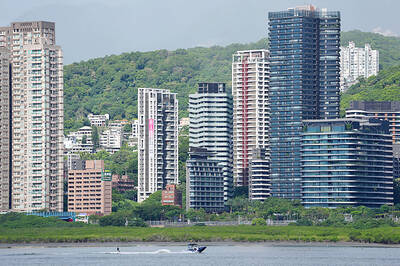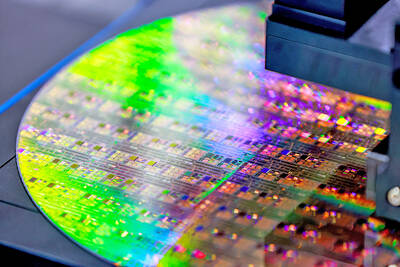LCD panel maker AU Optronics Corp (AUO, 友達) is poised to benefit from the imminent shutdown of a Samsung Display Co G8.5 fab, as the South Korean firm shifts away from LCD panel manufacturing, market researcher IHS Markit said on Thursday.
Beginning this month, Samsung Display plans to retire a G8.5 fab, L8, in two phases and convert it to make high-resolution 8K TV displays that use its Quantum Dot-OLED technology, the market researcher said, adding that this would reduce supply of LCD substrates by 125,000 units a month.
“South Korean and Taiwanese LCD panel makers are facing mounting pressure to transform quicker amid the rise of China,” David Hsieh (謝勤益), a senior display industry analyst with IHS Markit, told an annual display forum in Taipei.
To fend off competition from China, Taiwanese and South Korean companies are being forced to retire or covert older-generation fabs to make niche products as those fabs cannot match China’s new G10.5 fabs, Hsieh said.
“Samsung has taken the lead in retiring one of its four G8.5 fabs,” he added.
Samsung’s L8 fab primarily produces 55-inch and 45-inch TV panels, the research firm said.
China’s BOE Technology Group Co (京東方) launched the world’s first G10.5 fab in the second half of last year to produce 65-inch and 75-inch TV panels, which Samsung Display and AUO produce at G8 fabs, IHS Markit said.
Chinese panel maker China Star Optoelectronics Technology Co (華星光電) is struggling to overcome a low yield rate at its first G10.5 fab, and aims to ram up production at the fab this year, IHS Markit said.
“AUO and BOE are to benefit ... by supplying 55-inch TV panels to Samsung Display customers,” Hsieh said.
Samsung Display’s plan to close its L8 factory has raised concerns about potential supply constraints among TV makers and therefore stimulated unusual demand for smaller TV panels such as 32-inch panels, he said.
“TV assemblers have since the end of March been placing more orders to build up their inventory in preparation for the peak season in the second half of the year,” Hsieh said.
The demand has boosted TV panel prices, which could provide some relief to panelmakers, he said.
“However, we believe this will be a short-term rebound. After July, there will be an oversupply of panels which will challenge panel makers in the second half,” Hsieh said.

Taiwan’s rapidly aging population is fueling a sharp increase in homes occupied solely by elderly people, a trend that is reshaping the nation’s housing market and social fabric, real-estate brokers said yesterday. About 850,000 residences were occupied by elderly people in the first quarter, including 655,000 that housed only one resident, the Ministry of the Interior said. The figures have nearly doubled from a decade earlier, Great Home Realty Co (大家房屋) said, as people aged 65 and older now make up 20.8 percent of the population. “The so-called silver tsunami represents more than just a demographic shift — it could fundamentally redefine the

The US government on Wednesday sanctioned more than two dozen companies in China, Turkey and the United Arab Emirates, including offshoots of a US chip firm, accusing the businesses of providing illicit support to Iran’s military or proxies. The US Department of Commerce included two subsidiaries of US-based chip distributor Arrow Electronics Inc (艾睿電子) on its so-called entity list published on the federal register for facilitating purchases by Iran’s proxies of US tech. Arrow spokesman John Hourigan said that the subsidiaries have been operating in full compliance with US export control regulations and his company is discussing with the US Bureau of

Businesses across the global semiconductor supply chain are bracing themselves for disruptions from an escalating trade war, after China imposed curbs on rare earth mineral exports and the US responded with additional tariffs and restrictions on software sales to the Asian nation. China’s restrictions, the most targeted move yet to limit supplies of rare earth materials, represent the first major attempt by Beijing to exercise long-arm jurisdiction over foreign companies to target the semiconductor industry, threatening to stall the chips powering the artificial intelligence (AI) boom. They prompted US President Donald Trump on Friday to announce that he would impose an additional

Pegatron Corp (和碩), a key assembler of Apple Inc’s iPhones, on Thursday reported a 12.3 percent year-on-year decline in revenue for last quarter to NT$257.86 billion (US$8.44 billion), but it expects revenue to improve in the second half on traditional holiday demand. The fourth quarter is usually the peak season for its communications products, a company official said on condition of anonymity. As Apple released its new iPhone 17 series early last month, sales in the communications segment rose sequentially last month, the official said. Shipments to Apple have been stable and in line with earlier expectations, they said. Pegatron shipped 2.4 million notebook